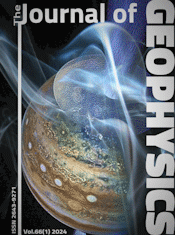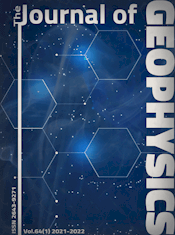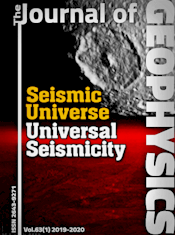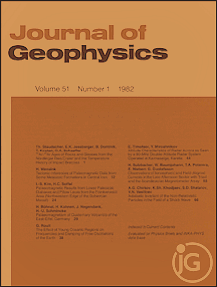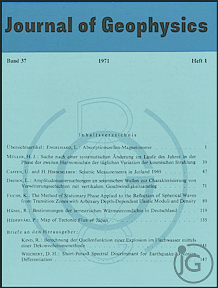Converted phases from the mantle transition zone observed at European stations
Article Sidebar
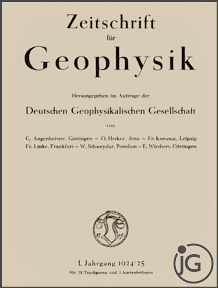
Vols. 1-18 (1924-1944), ISSN 0044-2801
Main Article Content
Abstract
Converted phases from the mantle transition zone have been observed as precursors about 1 min before the main S-wave phases S, SKS and ScS in long-period records of the Grafenberg array (GRF) and a few European WWSSN stations, at epicentral distances from 70-90°. The 23 earthquakes used were located along the west coast of America from Alaska to Ecuador, with a concentration of events in Central America, and in East Asia from the Aleutians through Japan to Sumatra. Relatively strong converted energy was observed for the American earthquakes, except for two events in the South Mexico/Guatemala region. The East Asian earthquakes produced significantly less precursor energy. The interference of conversions from P to SV below the focus and from SV to P below the stations is studied with theoretical-seismogram calculations. Due to interference precursors are normally stronger on the horizontal-radial than on the vertical component; this is in agreement with the observations. In special cases with either maximum or minimum P radiation towards the station conversion takes place only on one side, and precursor observations can be related directly to structure either below the focus or the station. The data set includes such favorable cases. The interpretation of observed precursors in terms of the fine structure in the conversion zone is difficult, even in favorable cases, because of the low resolving power of long-period converted phases. Nevertheless, the following conclusions can be drawn from the observations presented. Most of the precursor observations for the American events are compatible with typical models of the transition zone between upper and lower mantle, having two discontinuities at depths of about 400 and 670 km. Such a structure applies for western Europe and for the Caribbean Sea/Gulf of Mexico region, in the latter case with a possible local interruption by a smoother transition zone. A relatively smooth transition zone below East Asia from about Korea to the Sea of Okhotsk can also explain the lack of precursor energy for a few earthquakes in and close to Japan. These results indicate large-scale lateral variations in the sharpness of the mantle transition zone.
 ARK: https://n2t.net/ark:/88439/y031913
ARK: https://n2t.net/ark:/88439/y031913
Permalink: https://geophysicsjournal.com/article/265
Article Details
References
Baumgardt, D.R. (1981) Seismic body-wave study of vertical and lateral heterogeneity in the Earth's interior, Ph.D. thesis, Pennsylvania State University, 532 p.
Bock, G., Ha, J. (1984) Short-period S to P conversion in the mantle at a depth near 700 km, Geoph. J. R. Astron. Soc. 77 (In press)
Burdick, L.J. (1978) t* for S waves with a continental ray path, BSSA 68:1013-1030
Burdick, L.J. (1981) A comparison of the upper mantle structure beneath North America and Europe, J. Geophys. Res. 86:5926-5936
Burdick, L.J., Helmberger, D.V. (1978) The upper mantle P velocity structure of the western United States, J. Geophys. Res. 83:1699-1712
Chael, E.P., Stewart, G.S. (1982) Recent large earthquakes along the Middle American trench and their implications for the subduction process, J. Geophys. Res. 87:329-338
Faber, S., Muller, G. (1980) Sp phases from the transition zone between the upper and lower mantle, Bull. Seism. Soc. Am. 70:487-508
Given, J.W., Helmberger, D.V. (1980) Upper mantle of Northwestern Eurasia, J. Geophys. Res. 85:7183-7194
Helmberger, D.V., Engen, G.R. (1974) Upper mantle shear structure, J. Geophys. Res. 79:4017-4028
King, D.W., Calcagnile, G. (1976) P-wave velocities in the upper mantle beneath Fennoscandia and Western Russia, Geophys. J. R. Astron. Soc. 46:407-432
Masters, G., Jordan, T.H., Silver, P.O., Gilbert, F. (1982) Aspherical Earth structure from fundamental spheroidal-mode data, Nature 298:609-613
Rademacher, H., Odom, R.I., Kind, R. (1983) The upper mantle structure under south-east Europe derived from ORF broadband records of Greek earthquakes, J. Geophys. 52:7-13
Stewart, G.S., Chael, E.P., McNally, K.C. (1981) The November 29, 1978, Oaxaca, Mexico, earthquake: a large simple event, J. Geophys. Res. 86:5053-5060
Vinnik, L.P. (1977) Detection of waves converted from P to SV in the mantle, Phys. Earth Planet. Inter. 15:39-45
Vinnik, L.P., Avetisjan, R.A., Mikhailova, N.G. (1983) Heterogeneities in the mantle transition zone from observations of P-to-SV converted waves, Phys. Earth Planet. Inter. 33:149-163



